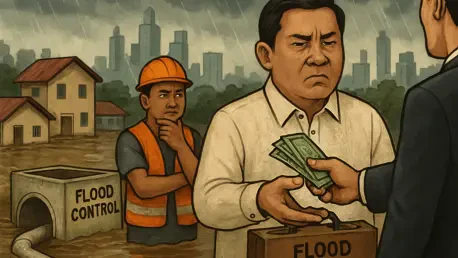In a nation frequently battered by typhoons and torrential rains, the integrity of flood-control infrastructure in the Philippines stands as a critical shield against disaster, yet recent revelations suggest that corruption may be undermining these vital defenses, casting doubt on the safety of millions. Reports have surfaced of a sprawling scandal involving key figures in both public and private sectors, casting a shadow over projects meant to protect communities from devastating floods. The Department of Justice (DOJ) has taken significant steps to address these allegations, placing dozens of individuals under scrutiny for their roles in what appears to be a systemic breach of trust. This development raises pressing questions about accountability and the safety of communities reliant on these public works. As investigations unfold, the scale of the issue becomes alarmingly clear, pointing to a network of potential fraud that could jeopardize lives and resources. This situation demands a closer look at how such irregularities have emerged and what measures are being implemented to curb them.
Uncovering the Scandal in Flood-Control Initiatives
A staggering 43 individuals, including contractors and officials from the Department of Public Works and Highways (DPWH), have been named in a recent Immigration Lookout Bulletin Order (ILBO) issued by the DOJ. This action, prompted by requests from the Senate Blue Ribbon Committee and the newly appointed DPWH chief, targets a mix of 26 private contractors and 17 government personnel suspected of involvement in fraudulent flood-control projects. The list spans a wide range of roles, from high-ranking undersecretaries to regional directors, engineers, and construction firm executives. Such diversity in the implicated parties suggests that the problem is not confined to a single level of operation but permeates multiple layers of responsibility. The sheer number of individuals under investigation highlights the potential depth of corruption within these critical infrastructure efforts, raising concerns about how funds have been allocated and whether projects meet necessary safety standards.
Beyond the numbers, the nature of the alleged misconduct points to a troubling pattern of mismanagement or intentional deceit in public works. While specific details about the anomalies—such as overpricing or incomplete projects—remain undisclosed, the involvement of both contractors and DPWH officials indicates possible collusion that undermines the purpose of flood-control systems. These initiatives are essential for a country prone to natural disasters, where poorly executed projects can lead to catastrophic consequences during heavy rains. The ILBO serves as a mechanism to monitor the movements of those named, reflecting a governmental intent to keep tabs on suspects as evidence is gathered. However, this measure alone does not guarantee immediate accountability, and it underscores the complexity of addressing corruption when it involves such a broad network. Public trust in infrastructure development hangs in the balance as these revelations continue to unfold.
Legal Measures and Their Limitations
The issuance of an ILBO against the 43 individuals marks a significant, yet preliminary, step in the fight against corruption in Philippine infrastructure projects. Unlike a Hold Departure Order (HDO), which requires court approval and explicitly prevents suspects from leaving the country, an ILBO merely allows the Bureau of Immigration to track travel activities without imposing restrictions. This distinction suggests that while authorities are taking the allegations seriously, the legal framework surrounding the investigation may still be in its early stages. The choice of an ILBO over an HDO could indicate that evidence is still being compiled or that the government is cautious about overstepping before formal charges are filed. For communities relying on effective flood defenses, this nuanced approach raises questions about the speed and efficacy of justice in cases of public fund misuse.
Delving deeper into the implications of these legal tools, the current measures reflect a broader challenge of balancing oversight with decisive action in governance. The ILBO, while useful for monitoring, does not address the immediate need to halt potentially ongoing fraudulent activities or to recover misappropriated resources. Critics might argue that stronger interventions are necessary to prevent further damage, especially in a sector as vital as flood control. Meanwhile, the involvement of high-profile figures from both the public and private sectors complicates the path to accountability, as political and economic influences could hinder swift resolution. The government’s response, though proactive in intent, must evolve to ensure that such scandals do not recur. As investigations progress, the focus will likely shift toward uncovering the full extent of the irregularities and implementing safeguards to protect public welfare from similar breaches in the future.
Systemic Challenges in Public Works Accountability
The scandal surrounding flood-control projects is emblematic of a recurring issue in Philippine governance: the struggle to maintain transparency and accountability in public works. The alleged corruption involving a wide array of individuals—from top DPWH officials to private contractors—points to systemic flaws that allow such irregularities to flourish. This is not merely a case of isolated wrongdoing but a reflection of deeper structural problems, where oversight mechanisms may be insufficient or easily circumvented. The safety of millions depends on the reliability of infrastructure like flood barriers, yet the apparent misuse of funds or substandard project execution threatens to render these protections ineffective. Addressing this requires not just punishing those involved but also reforming the processes that enable such lapses.
Furthermore, the complexity of rooting out corruption in a network as extensive as this cannot be overstated. The diversity of roles implicated in the scandal suggests that accountability must be pursued at multiple levels, from policy-making to on-ground implementation. Public trust, already fragile in the face of frequent natural disasters, suffers further when projects meant to safeguard lives are compromised by greed or negligence. The actions taken by the DOJ and DPWH leadership signal a commitment to tackling these issues, but the road ahead is fraught with challenges. Strengthening regulatory frameworks, enhancing whistleblower protections, and ensuring rigorous audits could serve as vital steps toward preventing future scandals. Only through sustained effort can confidence in public infrastructure be restored, ensuring that resources are used as intended for the benefit of all.
Reflecting on Steps Forward for Reform
Looking back, the response to the flood-control scandal demonstrated a pivotal moment when government bodies, including the DOJ and Senate, united to confront allegations of widespread corruption in Philippine infrastructure. The decision to issue an ILBO against 43 individuals was a calculated move to monitor suspects while investigations deepened, shedding light on the intricate web of public and private sector involvement. This episode underscored the urgent need for systemic change in how public works are managed and overseen. It became evident that without addressing the root causes of such breaches, the safety of vulnerable communities remained at risk. The actions taken, though initial, paved the way for a broader dialogue on governance and accountability. Moving forward, the focus must shift to implementing robust reforms, such as stricter project audits and transparent bidding processes, to prevent recurrence. Additionally, fostering a culture of integrity within public institutions could serve as a long-term solution, ensuring that flood-control projects truly fulfill their purpose of protecting lives and livelihoods.









